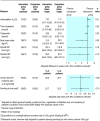Randomised controlled trial of patient centred care of diabetes in general practice: impact on current wellbeing and future disease risk. The Diabetes Care From Diagnosis Research Team
- PMID: 9794859
- PMCID: PMC28704
- DOI: 10.1136/bmj.317.7167.1202
Randomised controlled trial of patient centred care of diabetes in general practice: impact on current wellbeing and future disease risk. The Diabetes Care From Diagnosis Research Team
Abstract
Objective: To assess the effect of additional training of practice nurses and general practitioners in patient centred care on the lifestyle and psychological and physiological status of patients with newly diagnosed type 2 diabetes.
Design: Pragmatic parallel group design, with randomisation between practice teams to routine care (comparison group) or routine care plus additional training (intervention group); analysis at one year, allowing for practice effects and stratifiers; self reporting by patients on communication with practitioners, satisfaction with treatment, style of care, and lifestyle.
Setting: 41 practices (21 in intervention group, 20 in comparison group) in a health region in southern England.
Subjects: 250/360 patients (aged 30-70 years) diagnosed with type 2 diabetes and completing follow up at one year (142 in intervention group, 108 in comparison group).
Intervention: 1.5 days' group training for the doctors and nurses-introducing evidence for and skills of patient centred care and a patient held booklet encouraging questions.
Main outcome measures: Quality of life, wellbeing, haemoglobin A1c and lipid concentrations, blood pressure, body mass index (kg/m2).
Results: Compared with patients in the C group, those in the intervention group reported better communication with the doctors (odds ratio 2.8; 95% confidence interval 1.8 to 4.3) and greater treatment satisfaction (1.6; 1.1 to 2.5) and wellbeing (difference in means (d) 2.8; 0.4 to 5.2). However, their body mass index was significantly higher (d=2.0; 0.3 to 3.8), as were triglyceride concentrations (d=0.4 mmol/l; 0.07 to 0.73 mmol/l), whereas knowledge scores were lower (d=-2.74; -0.23 to -5.25). Differences in lifestyle and glycaemic control were not significant.
Conclusions: The findings suggest greater attention to the consultation process than to preventive care among trained practitioners; those committed to achieving the benefits of patient centred consulting should not lose the focus on disease management.
Figures
Comment in
-
Patient centred care of diabetes in general practice. Study failed to measure patient centredness of GPs' consulting behavior.BMJ. 1999 Jun 12;318(7198):1621-2; author reply 1622. BMJ. 1999. PMID: 10428561 No abstract available.
-
Patient centred care of diabetes in general practice. Might difference in prescribing explain some of the findings?BMJ. 1999 Jun 12;318(7198):1622. BMJ. 1999. PMID: 10428562 No abstract available.
References
-
- Katz J. The silent world of doctor and patient. New York: Free Press; 1984.
-
- Stewart M, Brown JB, Weston WW, McWhinney IR, McWilliam CL, Freeman TR. Patient-centred medicine: transforming the clinical method. Thousand Oaks, CA: Sage; 1995.
-
- Sullivan FM, MacNaughton RJM. Evidence in consultations: interpreted and individualised. Lancet. 1996;348:941–943. - PubMed
-
- Evans BJ, Kiellerup FD, Standley RO, Burrows GD, Sweet B. A communication skills programme for increasing patient’s satisfaction with general practice consultations. Br J Med Psychol. 1987;60:373–378. - PubMed
Publication types
MeSH terms
Grants and funding
LinkOut - more resources
Full Text Sources
Medical




